How the Germans took Kiev
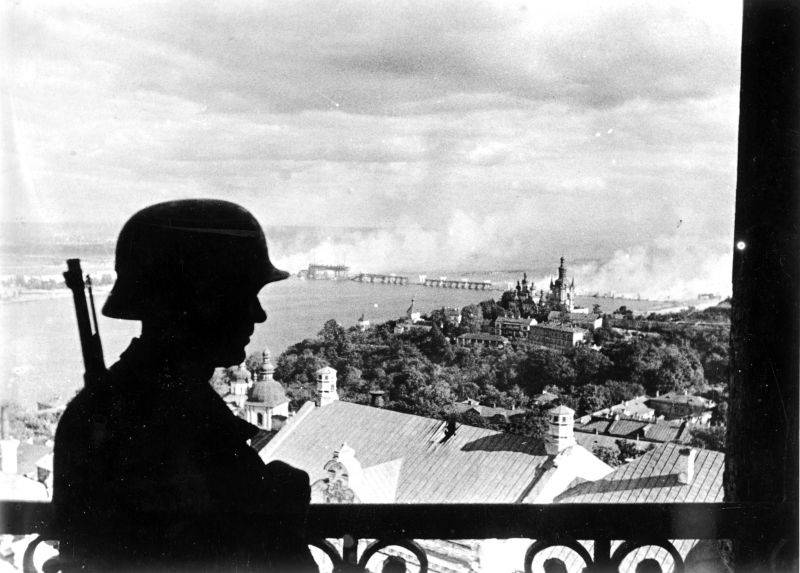
A German sentry on the bell tower of the Kiev-Pechersk Lavra against the background of a burning bridge over the Dnieper. September 19, 1941
80 years ago, the Germans surrounded the Soviet armies near Kiev. Troops of the German 1st tank Army Group South on September 16, 1941 joined up in the Lokhvitsa area with the 2nd Panzer Group, advancing from north to south.
The 5th, 37th, 26th armies and partially the troops of the 38th and 21st armies of the Southwestern Front were surrounded. On September 18, 1941, the Nazis occupied Poltava. On the night of September 19, our troops left Kiev. Our armies could not break through from the "cauldron" to the east and were defeated by September 24-26. The front command, led by the front commander Kirponos, was killed. The Kiev catastrophe led to the loss of about 500 thousand soldiers and officers. According to German data, over 600 thousand people were taken prisoner alone.
Battle in the Kiev direction
Given the difficult situation at the front, the Headquarters of the Supreme High Command on June 30, 1941 ordered the commander of the South-Western Front to withdraw troops to the line of fortified areas on the former state border of 1939 and, relying on them, to organize a solid defense. The 5th Army withdrew to the Korosten UR, and the 6th Army - to the area of Berdichev and to the south, with the task of taking up defenses in the Novograd-Volynsk UR.
The Germans broke through the Soviet defenses at the junction of our two armies and captured Zhitomir on July 9. The battle for Kiev began on July 11, 1941. On this day, the German 3rd Motorized Corps broke through from Zhitomir to the front edge of the Kiev fortified area. German two tank divisions, moving along the Kiev highway, reached the Irpen River, 20 km west of the ancient Russian capital. This strike was accompanied by massive airstrikes against our troops, communications and deep rear facilities. There was a threat of the fall of Kiev and the capture by the enemy of the crossings across the Dnieper.
The 5th Army of General Potapov with the forces of the shock group (31st Rifle Corps, 9th, 19th and 22nd Mechanized Corps) dealt a counterattack on the formations of the 6th Field Army of Reichenau and the 1st Panzer Group of Kleist in the Novograd area. Volynsky. Soviet troops attacked the flank of a German strike group aimed at Kiev. This forced the German command to reinforce the northern flank with 9 divisions from the 1st Panzer Group and the left flank of the 6th Army. The blow of the 5th Soviet Army temporarily distracted the enemy from Kiev.
After repelling Soviet counterattacks, Mackensen's German 3rd Motorized Corps trampled under Kiev for two weeks, waiting for the approach of the 6th Army's infantry divisions. Having met strong resistance of Russian troops in the Kiev direction, the Germans turned south to reach the rear of the 6th, 12th and 18th armies, which were retreating from the Berdichev - Starokonstantinov - Proskurov line. The German 48th motorized corps developed an offensive to the southeast, and the 14th motorized corps advanced between the 3rd and 48th. The Soviet 26th army Kostenko inflicted a counterattack on the 14th motorized corps at Fastov.
In mid-July, the 17th German army of Stülpnagel developed an offensive in the Vinnitsa direction. The Soviet 12th Army of Ponedelin left Vinnitsa. A wide gap formed between the Soviet 26th and 6th armies in the area of Belaya Tserkov. Our 6th and 12th armies are retreating to the Uman region.
The situation worsened due to the breakthrough of the defense of the Southern Front by the 11th German army. The Germans developed their offensive with the forces of the 1st Panzer Group and the 17th Army. In early August 1941, the Uman cauldron was formed, in which the troops of the 6th and 12th armies, the 2nd mechanized corps were found. The Soviet troops could not break through and resisted until August 8-10. Up to 65 thousand soldiers and officers got into the encirclement, about 11 thousand came out of it. According to German data, more than 100 thousand people were taken prisoner alone. In captivity were also two commanders Muzychenko and Ponedelin, almost all the corps commanders were killed or taken prisoner.
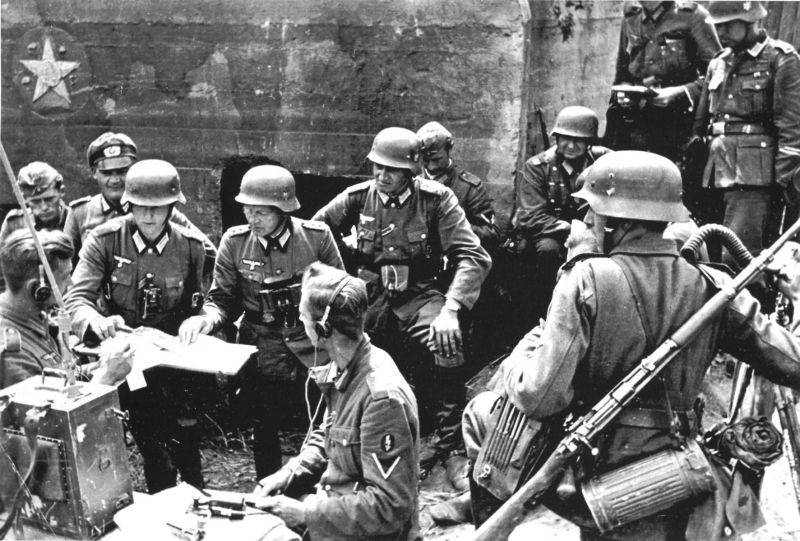
German soldiers and officers stand near the pillbox of the Kiev fortified area
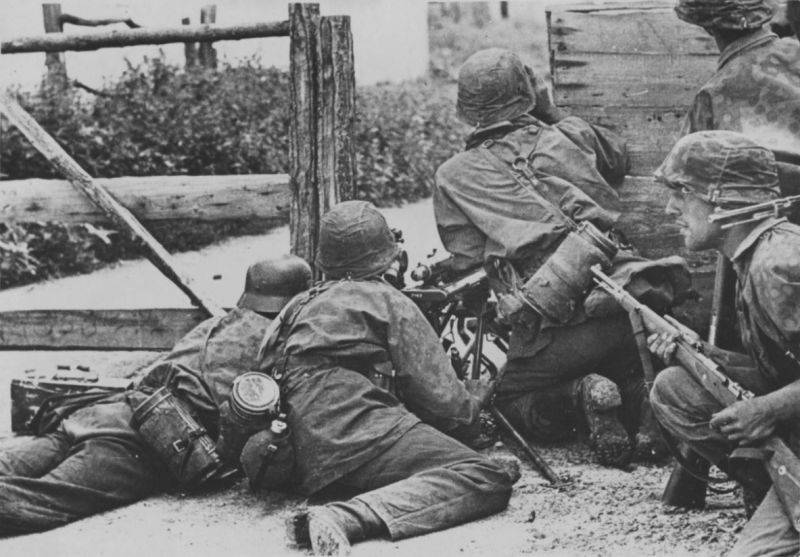
SS soldiers at the MG-34 machine gun during street fighting in Kiev
German Command Plans
On July 8, 1941, the German Headquarters ordered to break the enemy's resistance in the central (Moscow) direction and open the way to Moscow. Then the 3rd Panzer Group of Hoth was planned to be sent to the north, and the 2nd Panzer Group of Guderian to the south and southeast, east of the Dnieper, to support the offensive of Army Group South.
The strong resistance of the Red Army, unexpected for the enemy, especially on the strategic flanks of the Russian Front, forced the German High Command to reconsider operational and strategic decisions. On July 21, Hitler arrived at the headquarters of Army Group North. The meeting confirmed the decision to turn the 3rd Panzer Group to the northeast to accelerate the capture of Leningrad and the 2nd Panzer Group to the southeast.
In the directive of the OKW (High Command of the Wehrmacht) No. 33 of July 19, it was noted that in the southern sector of the front it was necessary to occupy Ukraine, Crimea and the territory to the Don. In the central sector - to capture Moscow, the 3rd Panzer Group was temporarily transferred to Army Group North. But already on July 30, OKW issued directive No. 34, according to which Army Group Center received an order to stop the offensive in the Moscow direction and go on the defensive.
The fact is that Brauchitsch and Halder, the commander-in-chief and chief of the General Staff of the ground forces, saw a looming crisis in a simultaneous offensive in three strategic directions. Therefore, they considered it expedient to concentrate their forces on the capture of Moscow, which would lead to the fall of the Russian defense. Here you can destroy the main forces of the Russians, since they will fight for the capital to the last and will throw all the remaining reserves into battle. As a result, the Germans will destroy the main forces and reserves of the enemy, their center of command and communications, the most important industrial area. Russia will be split into northern and southern parts, which will greatly complicate further resistance.
Hitler, with the support of Keitel and Jodl - the chief of staff of the OKW, the chief of staff of the operational leadership of the OKW, believed that instead of attacking Moscow, it was first necessary to defeat the enemy on the flanks. It was necessary to remove a possible threat from the flanks of Army Group Center. Hitler also believed that it was extremely important for victory in the war to seize the strategic resources of Ukraine and the Caucasus.
In the southern direction, the Russian troops actively resisted, inflicted strong counterattacks, preventing the Germans from reaching Kiev and not allowing them to break through to the south along the Dnieper in order to encircle the main forces of the Southwestern and Southern Fronts.
The available forces of Army Group South were not enough to fulfill the task assigned to it.
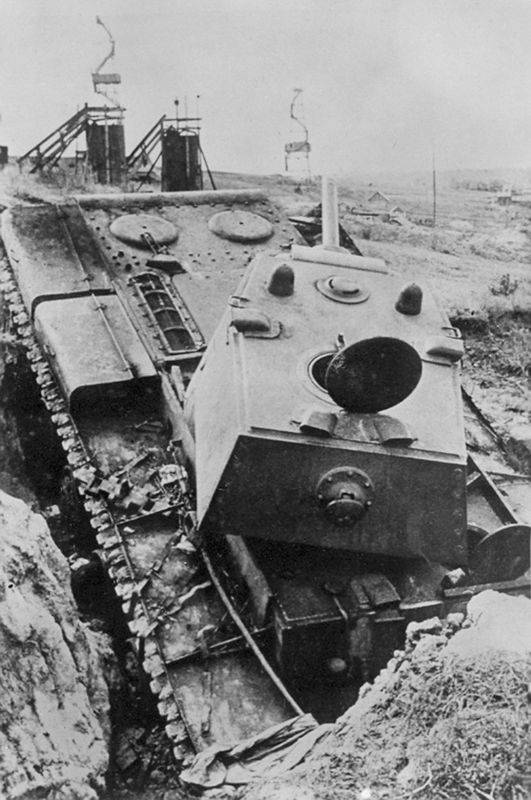
Soviet tank KV-1 stuck and abandoned near the town of Romny
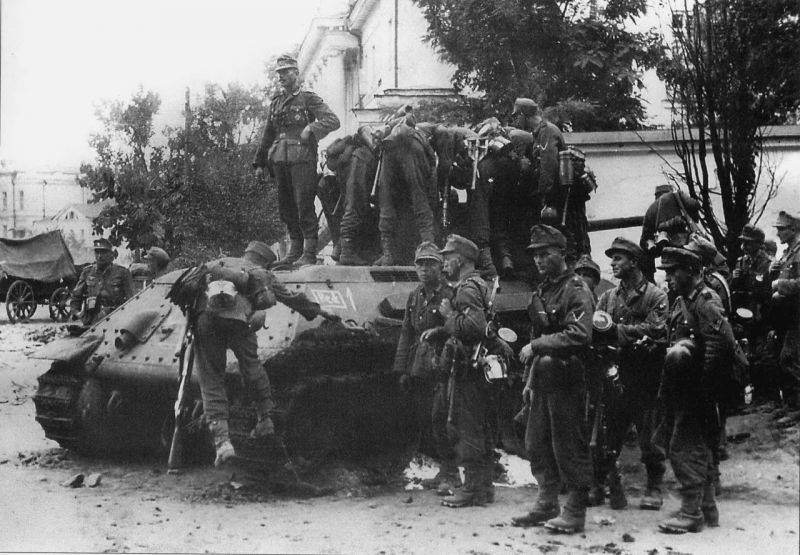
German mountain shooters examine the Soviet T-34 tank, knocked out in the park of Poltava. September 1941
To Kiev
The battle for Kiev took on an even more fierce character.
The Nazis needed to take the city in order to solve the most important part of the overall strategic war plan. The Germans could not develop an offensive while the Dnieper line was covered by a strong group of Russian troops. In the Kiev area, the Germans were held back by the organized resistance of several Soviet armies. The townspeople took an active part in the defense of Kiev. Since the beginning of the war, more than 200 thousand Kievites (including 16 thousand communists and 40 thousand Komsomol members) voluntarily joined the ranks of the Red Army. A popular militia was also formed. More than 160 thousand townspeople built defensive lines every day. Three defense lines were erected, a 3-kilometer anti-tank ditch was opened, about 25 bunkers were built, etc.
Hitler ordered to take Kiev on August 8, 1941 and hold a military parade on Khreshchatyk. However, this order was not carried out.
Until August 11, the Nazis, with the support of large artillery forces and aviation continuously, day and night, the defensive formations of the Kiev fortified area and the 27th rifle corps were attacked. The Germans did not succeed.
The command of the SWF threw the last reserves to defend the city. A threat arose for Odessa, on August 5, the heroic defense of the city began. The city was defended by a separate Primorsky army, the forces and means of the Odessa naval base and the Black Sea fleet.
In August, the Germans captured the entire Right-Bank Ukraine, but the districts of Kiev and Odessa held on, preventing the enemy from breaking through further. The German Headquarters was deeply concerned about the backlog of Army Group South, which disrupted its interaction with Army Group Center.
On August 10, Chief of Staff of Army Group South Sodenstern reported to Halder:
Lacking strategic reserves, the German Headquarters decides to temporarily transfer part of the forces of Army Group Center - Weichs's 2nd Army and Guderian's 2nd Panzer Group - to reinforce Army Group South. This was supposed to ensure the capture of the Dnieper line, a breakthrough into the Crimea and the Caucasus.
On August 21, Hitler signed a directive according to which part of the forces of Army Group Center turned south in order to defeat the main forces of the Soviet SWF. The main task was not the capture of Moscow, but the capture of the Crimea, industrial and coal regions on the Donets, depriving the Russians of oil from the Caucasus.
On 23 August, the headquarters of Army Group Center received a corresponding order from the Fuehrer. The command of Army Group Center met this decision of Hitler with disapproval. Guderian personally tried to persuade the Fuhrer to continue the offensive against Moscow, but achieved nothing.
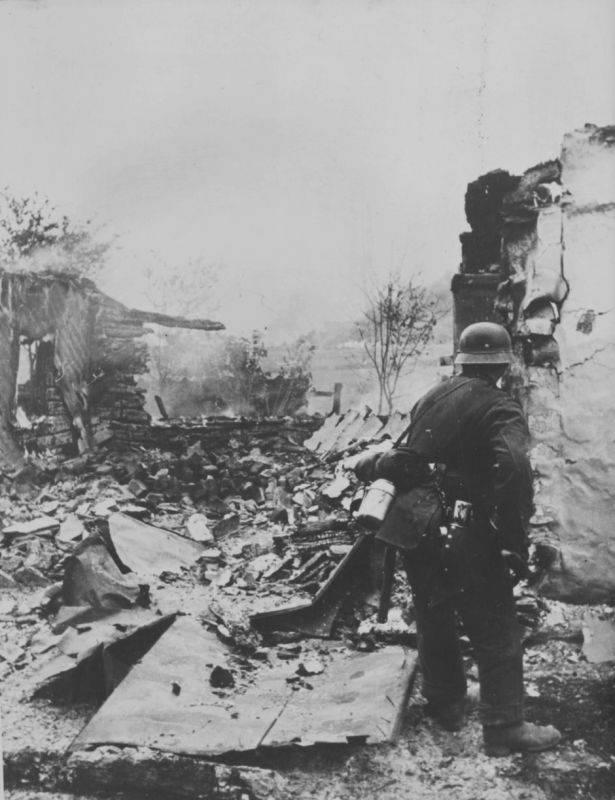
German machine gunner, armed with a 7,92-mm MG-34 light machine gun, at the ruins of a burned down house on the outskirts of Kiev
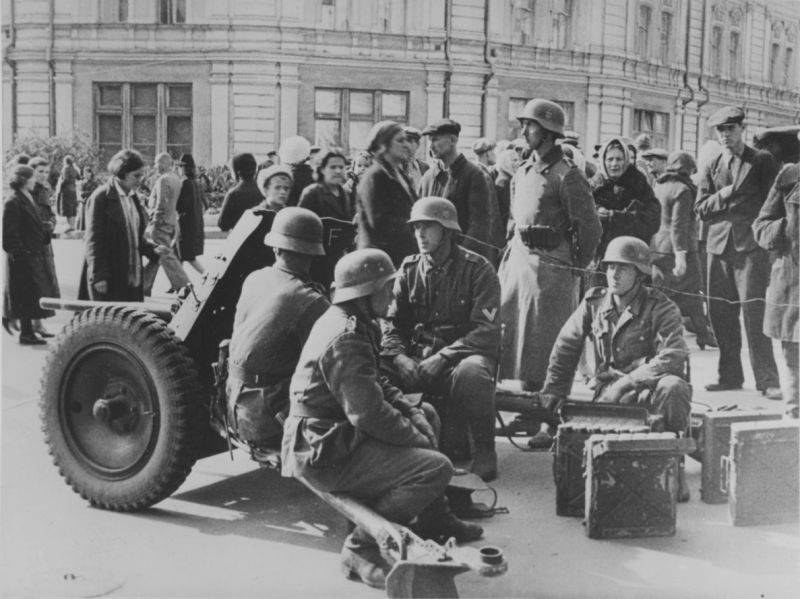
Calculation of the German 37-mm cannon PaK 35/36 on vacation on Khreshchatyk in Kiev near the building of the regional committee
The environment of the Kiev group
The German 2nd Army and 2nd Panzer Group were turned south to encircle and defeat the troops of the South-Western Front's right wing. This immediately complicated the situation in the zone of the Central Front.
The 21st Army retreated to Chernigov, where the Nazis were rushing. The Soviet Headquarters allowed to withdraw part of the troops (5th Army and 27th Corps) from the right wing of the South-Western Front to the eastern bank of the Dnieper. The Kiev group remained in place with the order to defend Kiev to the last.
In early September 1941, the enemy's northern grouping reached the lower reaches of the river. Desna, and the southern grouping (1st Panzer Group and 17th Army) captured and expanded the bridgehead in the Kremenchug area on the left bank of the Dnieper. It was clear that two German groups were trying to encircle the main forces of the SWF.
The Soviet Headquarters instructed the newly created Bryansk Front to counter-attack Guderian's group and prevent it from breaking through to the south. The 2nd Cavalry Corps, directed by the Southern Front to Romny, was going to move to the Putivl area. However, the troops of the Bryansk Front, due to lack of time for a counterattack and errors of the command, could not stop the enemy's breakthrough.
The Nazis pushed back and bypassed the 21st Army of the Bryansk Front on the left. On September 7, German tanks reached Konotop, on the 9th Chernigov fell.
The 21st army of Kuznetsov, which was bypassed from the east by the troops of the 2nd tank group, and from the west by the 2nd German army, which reached Chernigov, was under the threat of encirclement and began to hastily retreat south to the Desna. Continuing to cover the troops of the South-Western Front, Guderian's group defeated the 40th Army of Podlas and entered the Romen area. The 40th Army retreated to the southeast.
By this time, the reserves of the SWF were exhausted.
The commander-in-chief of the South-Western direction Budyonny, the chief of the Operations Directorate of the General Staff Vasilevsky, the commander of the South-Western Front Kirponos, the chief of staff of the South-Western Front Tupikov repeatedly suggested leaving Kiev and withdrawing troops from the Dnieper border to the river. Psel. However, this proposal did not receive timely approval. Chief of the General Staff Shaposhnikov opposed this decision. The headquarters proposed to first stop the enemy's northern group and create a line of defense on the river. Psellus and only then leave Kiev.
Stalin hoped that the SWF would have enough strength to resist. Meanwhile, the armies of the Western, Reserve and Bryansk fronts will strike at the flank and rear of the German northern grouping, stop it.
On September 12, Marshal Budyonny was removed from his post as commander-in-chief of the South-West direction. He was replaced by Tymoshenko. On September 13, tanks of the 3rd Panzer Division from the 2nd Panzer Group reached Lokhvitsa. About 60 km remained between the two German wedges, it was no longer possible to withdraw the troops of the South-Western Front. It was necessary to organize a breakthrough of the Kiev group and a strong counter strike.
On September 14, the 3rd and 16th Panzer Divisions of Model and Hube captured Lokhvitsa and Lubny. But because of the strong resistance of the Russians, they could not complete the encirclement. The German 9th Panzer Division from the 1st Panzer Group entered the Lokhvice area.
On September 16, the Germans closed the encirclement.
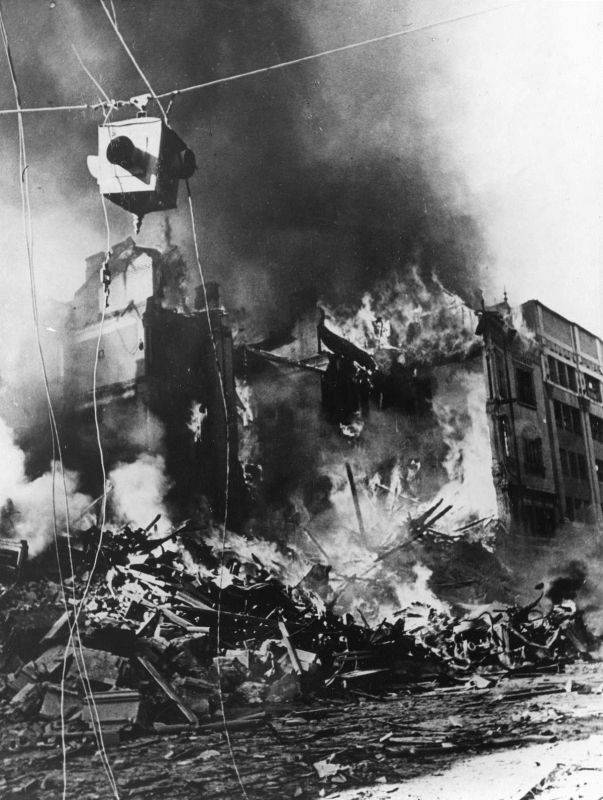
Burning destroyed building in Kiev captured by the Germans
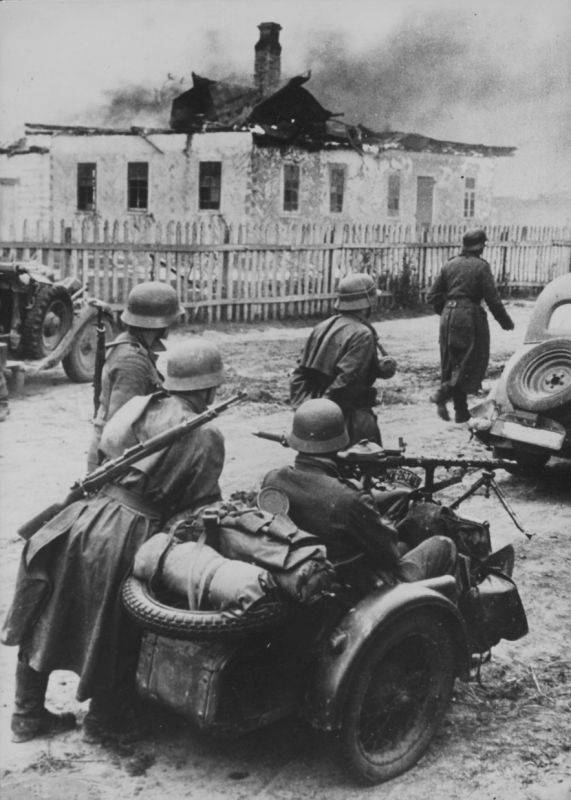
A group of German soldiers at a motorcycle during a battle on the outskirts of Kiev
Catastrophe
The cauldron got the troops of the 5th, 26th and 37th and partially the troops of the 38th and 21st armies of the Southwestern Front.
On September 16, Tymoshenko ordered to leave Kiev and withdraw troops to the line of the r. Psel.
In the evening of the 17th front commander, Kirponos ordered the armies to break through to the east. The 38th and 40th armies with strikes on Romny and Lubny were supposed to help break through the armies of the South-Western Front. Due to a communication failure, the 37th Army did not receive an order to withdraw and continued to defend Kiev. Only on September 19 did her troops leave Kiev.
It was not possible to organize a retreat.
The troops withdrew without control, disorganized, most often in small groups, pressed from all sides by the enemy and suffered heavy losses.
So, on September 20, the combined column of the headquarters of the Southwestern Front and the 5th Army approached the village of Dryukovshchina, in the area southwest of Lokhvitsa, where it was attacked by the troops of the German 3rd Panzer Division. The column was defeated, Mikhail Kirponos, members of the Front Military Council, Mikhail Burmistenko, Yevgeny Rykov, Chief of Staff Vasily Tupikov, members of the 5th Army Armed Forces Nikishev and Kalchenko, and Chief of Staff of the 5th Army Pisarevsky were killed. The commander of the 5th Army Mikhail Potapov was seriously wounded and taken prisoner.
It is interesting that the group (NKVD company) of the head of the operational department of the headquarters of the South-Western Front Baghramyan, which was supposed to cover the breakthrough of the main column, successfully passed the German barriers and went out to its own.
On September 21-23, the 37th Army was defeated in the Kiev region. His army commander Vlasov (was wounded) with a small group made his way to his own. The Pyriatinsky group of the troops of the 5th and 21st armies held out until September 25.
The remnants of the 5th Army came out of the encirclement in different places, going from Chernigov to Orzhitsa and further to the river. Psel. In the Orzhitsa area, the remnants of the 26th Army fought the longest - until September 26th. The commander of the 26th Army, General Kostenko, with the army headquarters managed to organize a breakthrough of the encirclement ring and the exit of the headquarters and part of the troops to their own.
Soviet troops suffered heavy losses.
According to data published in 1993 by the General Staff of the RF Armed Forces, our losses amounted to over 700 thousand people, of which 627 thousand are irrecoverable. According to German data, over 600 thousand people were taken prisoner alone.
The Germans opened their way to the east, as a result, the entire Left-Bank Ukraine was lost, the Germans reached the Donbass. The armies of the Southern Front found themselves in a difficult situation. In the Azov region, the 18th army perished, they had to leave Odessa. The Nazis captured Taganrog, Kharkov and broke through to the Crimea. The defense of Sevastopol began.
However, the battle for Kiev also had a positive result. The Germans suspended the offensive on Moscow, which made it possible to strengthen its defenses.
The fierce resistance of the SWF troops for a long time fettered Army Group South.
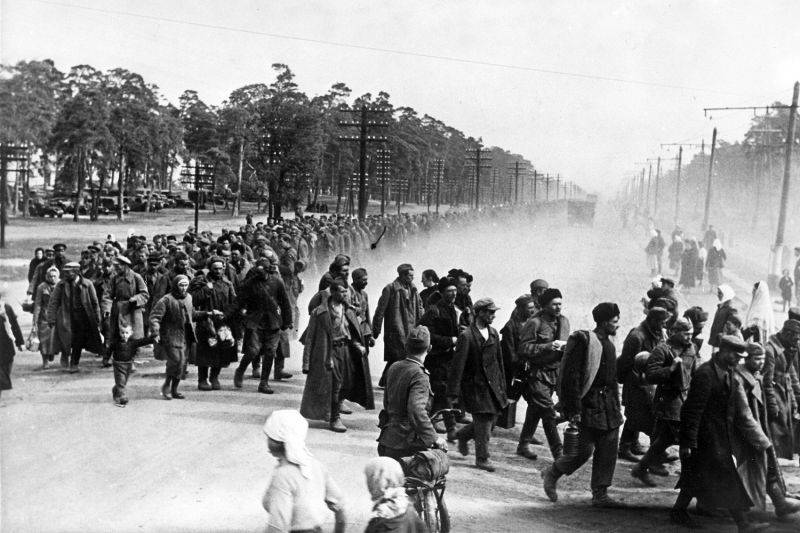
Column of captured Red Army soldiers near Kiev
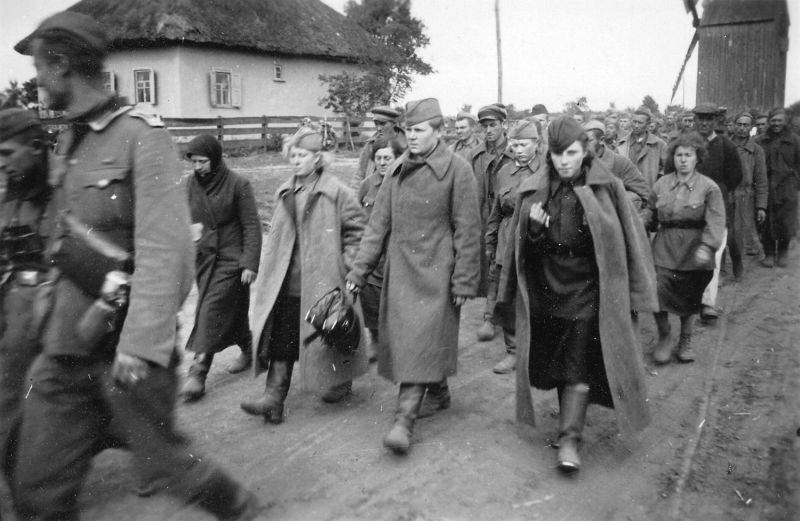
A column of captured Red Army soldiers in the vicinity of Kremenchug, Ukraine. September 1941
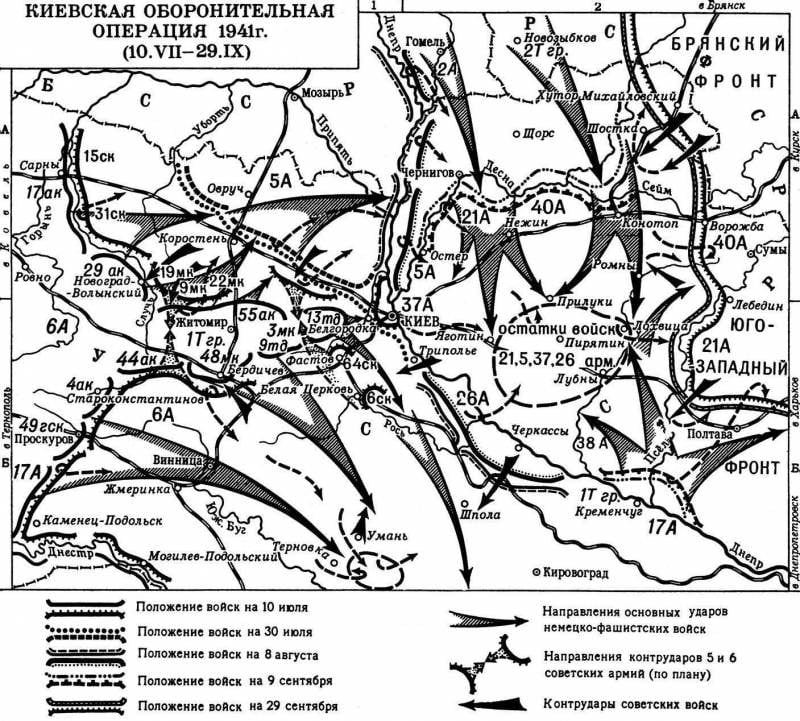
Information